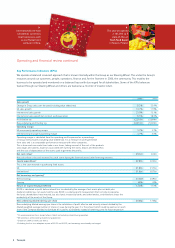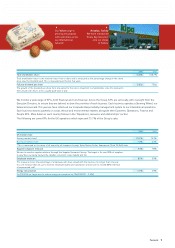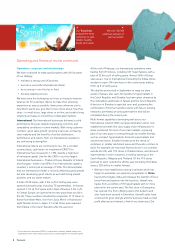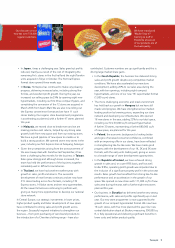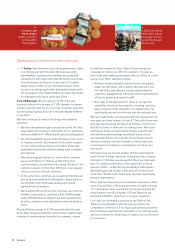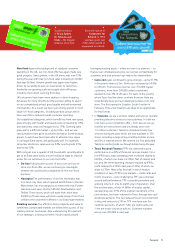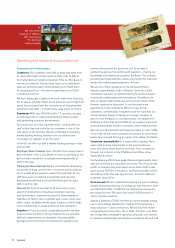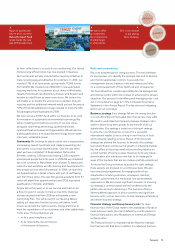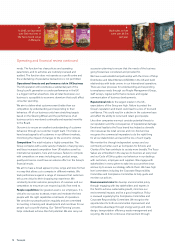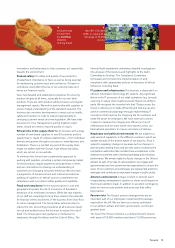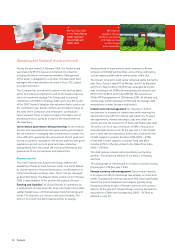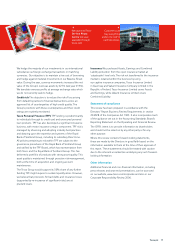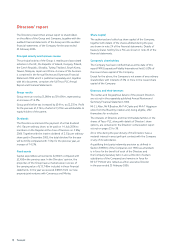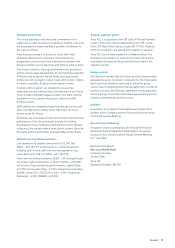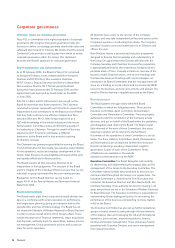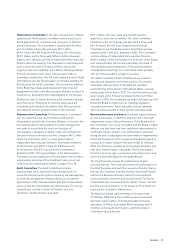Tesco 2006 Annual Report Download - page 18
Download and view the complete annual report
Please find page 18 of the 2006 Tesco annual report below. You can navigate through the pages in the report by either clicking on the pages listed below, or by using the keyword search tool below to find specific information within the annual report.
16 Tesco plc
Operating and financial review continued
During the year ended 25 February 2006, the Trustee board
was chaired by Mr R S Ager and comprised nine directors
including the three nominated by members. Management
of the assets is delegated to a number of independent fund
managers who have discretion to invest in Tesco PLC subject
to certain restrictions.
The Company has considered its pension risks and has taken
action by increasing contributions and by the Trustee reducing
risk in its investment strategy. The Group paid in a special
contribution of £200m in February 2005 and, since the results
of the 2005 Trustee’s Valuation (the valuation that is used to set
the contribution rate, details of which are included on page 5),
the rates of the Company’s and employees’ contributions
have increased. These increases recognise the higher cost of
providing pensions, partly as a result of the improvement in
life expectancy.
Joint venturegovernance and partnerships As we continue
to enter into new partnerships and grow existing joint ventures
the risk inherent in managing these partnerships increases. It is
moredifficult to guarantee the achievement of joint goals and
werely on partners’ reputations. We choose partners with good
reputations and set out joint goals and clear contractual
arrangements from the outset. We monitor performance and
governance of our joint ventures and partnerships.
Financial review
The main financial risks faced by the Group relate to the
availability of funds to meet business needs, the risk of default
by counter-parties to financial transactions, and fluctuations in
interestand foreign exchange rates. These risks are managed
as described below. The Balance Sheet position at 25 February
2006 is representative of the position throughout the year.
Funding and liquidity The Group finances its operations by
a combination of retained profits, long and medium-term debt,
capital market issues, commercial paper, bank borrowings and
leases. The objective is to ensure continuity of funding. The
policy is to smooth the debt maturity profile, to arrange
funding ahead of requirements and to maintain sufficient
undrawn committed bank facilities, and a strong credit rating
so that maturing debt may be refinanced as it falls due.
The Group’s long-term credit rating remained stable during the
year. Tesco Group is rated A1 by Moody’s and A+ by Standard
and Poor’s. New funding of £529m was arranged during the
year, including a net £484m from property joint ventures and
£45m from medium-term notes (MTNs). We renewed our
€10bn MTN programme on 28 February 2006. At the year end,
net debt was £4.5bn (last year £3.9bn) and the average debt
maturity was six years (last year eight years).
Interest rate risk management The objective is to limit
our exposure to increases in interest rates while retaining the
opportunity to benefit from interest rate reductions. Forward
rate agreements, interest rate swaps, caps and collars are
used to achieve the desired mix of fixed and floating rate debt.
The policy is to fix or cap a minimum of 40% of actual and
projected debt interest costs. At the year end, £1.5bn of debt
was in fixed rate form (last year £2.6bn) with a further £0.9bn
of debt capped or collared, therefore 53% (2005 – 87%)
of net debtis fixed, capped or collared. Fixed rate debt
includes £472m of funding linked tothe Retail Price Index
(2005 – £454m).
This debt reduces interestrisk by diversifying our funding
portfolio. The remaining balance of our debt is in floating
rateform.
The average rate of interest paid on a historic cost basis during
the year was 5.2% (last year 5.4%).
Foreign currency risk management Our principal objective
is toreduce the effect of exchange rate volatility on short-term
profits. Transactional currency exposures that could significantly
impact the Income Statement are hedged, typically using
forward purchases or sales of foreign currencies and currency
options. At the year end, forward foreign currency transactions
equivalent to £548m were outstanding (2005 – £479m) as
detailed in note 20.
3
We have launched
anew Tesco Bonus
credit card and
Tesco Clubcard
credit card.
4
We treat our
suppliers the way
we like to be treated
and make sure we
are fair, honest
and responsible.


